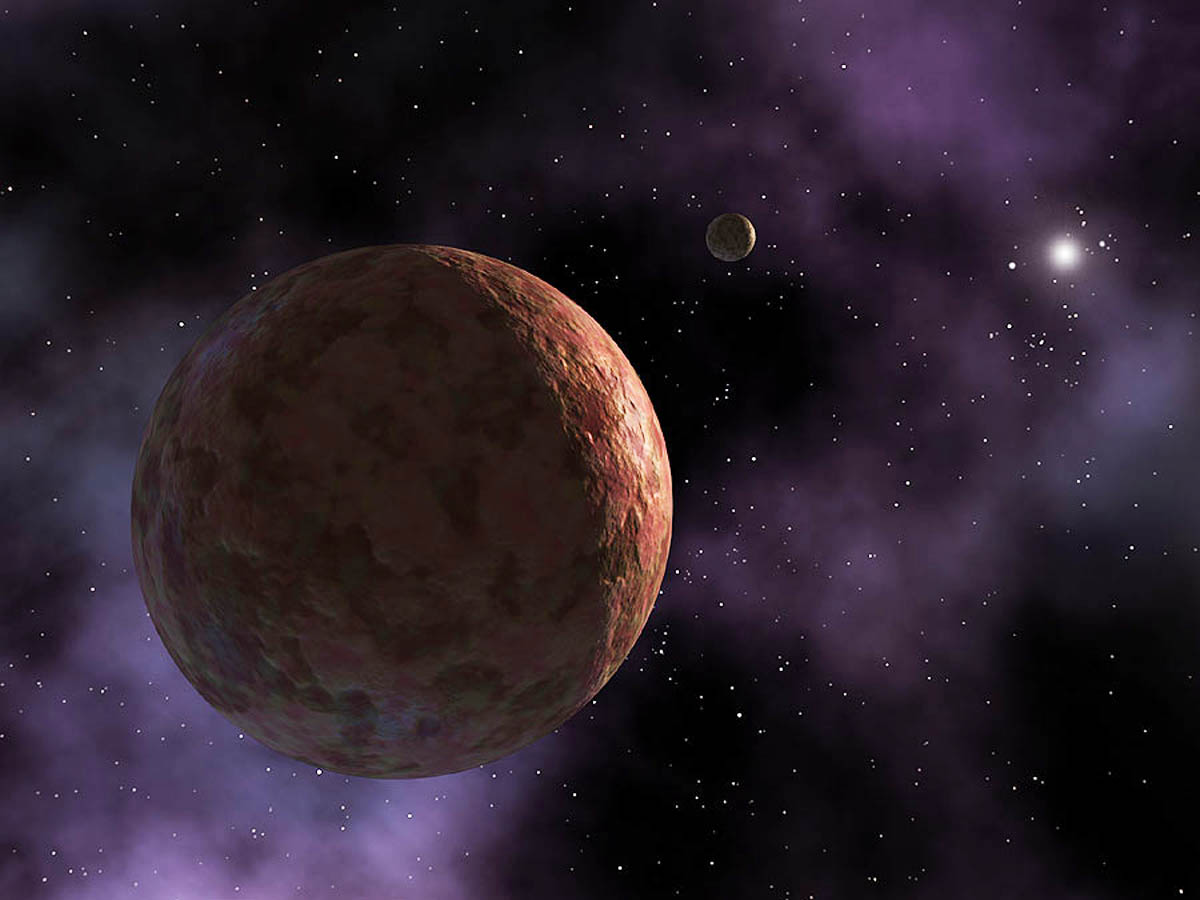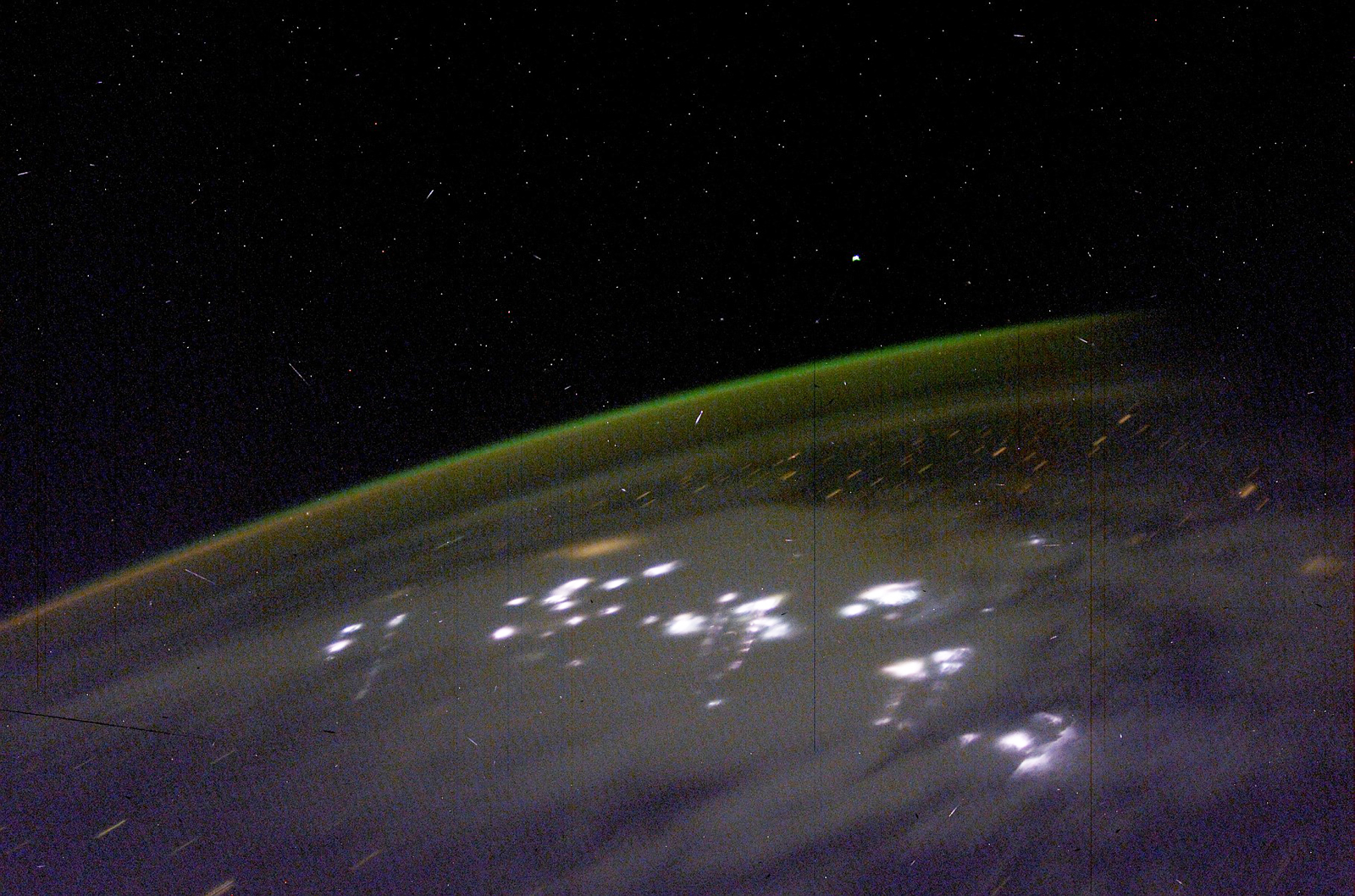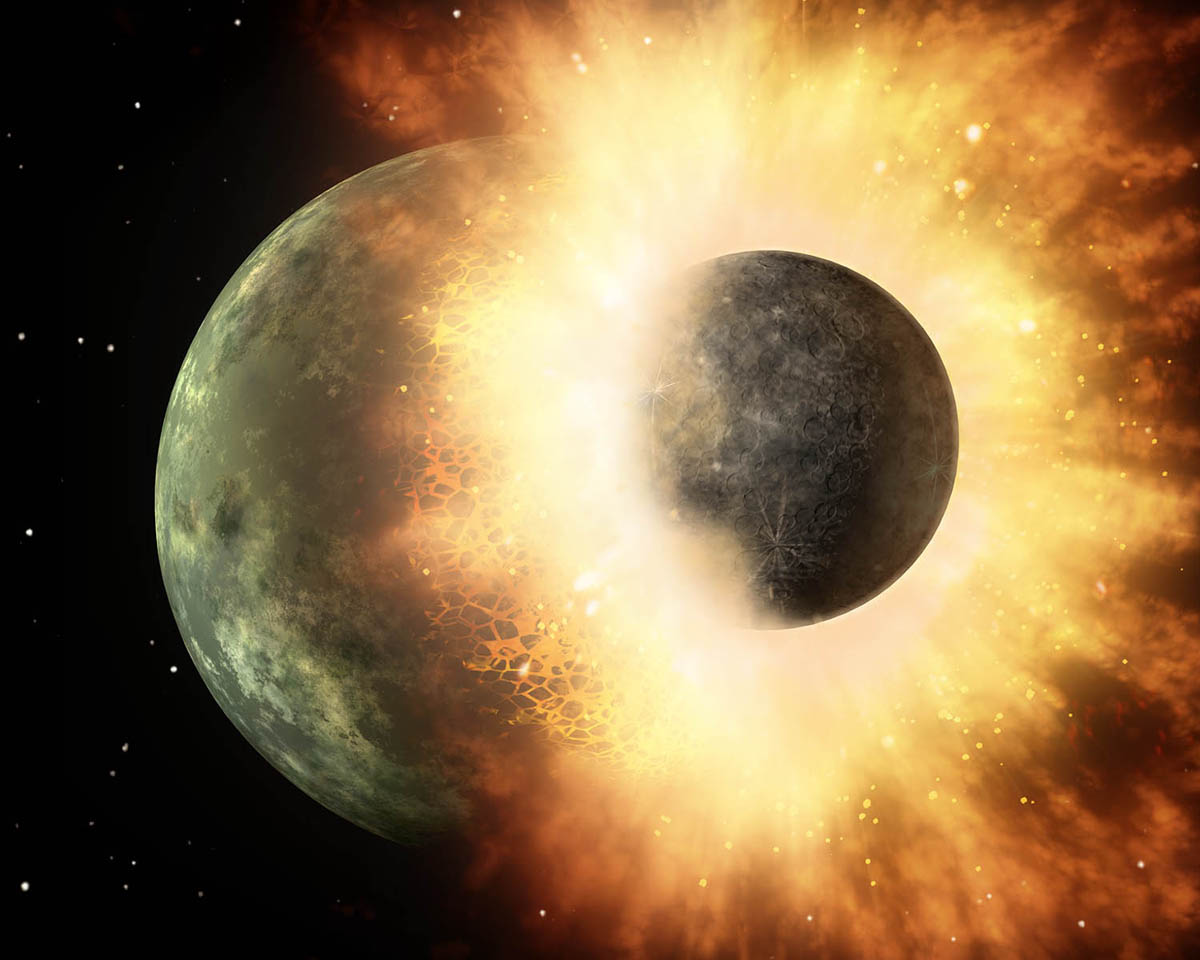Next Launch
Total Students
2,609
Total Launches
683
Eggs Survived
418 61.2%
Rockets Survived
536 78.5%
Aug. 1, 2009
A Planet Named Easterbunny?
by Staff
You know Uranus, Neptune, and Pluto. But how about their smaller cousins Eris, Ceres, Orcus, and Makemake? How about Easterbunny?
These are all names given to relatively large “planet-like” objects recently found in the outer reaches of our solar system. Some were just temporary nicknames, others are now official and permanent. Each has a unique story.
“The names we chose are important,” says Caltech astronomer Mike Brown, who had a hand in many of the discoveries. “These objects are a part of our solar system; they're in our neighborhood. We ‘gravitate’ to them more if they have real names, instead of technical names like 2003 UB313.”
Nearby planets such as Venus and Mars have been known since antiquity and were named by the ancient Romans after their gods. In modern times, though, who gets to name newly discovered dwarf planets and other important solar-system bodies?
In short, whoever finds it names it. For example, a few days after Easter 2005, Brown and his colleagues discovered a bright dwarf planet orbiting in the Kuiper belt. The team’s informal nickname for this new object quickly became Easterbunny.
However, ever since its formation in 1919, the International Astronomical Union (IAU) ultimately decides whether to accept or reject the name suggested by an object’s discoverers. "Easterbunny" probably wouldn’t be approved.
According to IAU guidelines, comets are named after whoever discovered them—such as comet Hale-Bopp, named after its discoverers Alan Hale and Thomas Bopp. Asteroids can be named almost anything. IAU rules state that objects in the Kuiper belt should be given mythological names related to creation.
So Brown’s team started brainstorming. They considered several Easter-esque names: Eostre, the pagan mythological figure that may be Easter’s namesake; Manabozho, the Algonquin rabbit trickster god.
In the end, they settled on Makemake (pronounced MAH-kay MAH-kay), the creator of humanity in the mythology of Easter Island, so named because Europeans first arrived there on Easter 1722
Other names have other rationales. The dwarf planet discovered in 2005 that triggered a fierce debate over Pluto’s status was named Eris, for the Greek goddess of strife and discord. Another dwarf planet with an orbit that mirrors Pluto’s was dubbed Orcus, a god in Etruscan mythology that, like Pluto, ruled the underworld.
Brown says he takes “this naming business” very seriously and probably spends too much time on it. “But I enjoy it.” More tales of discovery and naming may be found in Brown's blog MikeBrownsPlanets.com.
Constellations have also been named after ancient gods, human figures, and animals. Kids can start to learn their constellations by making a Star Finder for this month at spaceplace.nasa.gov/en/kids/st6starfinder/st6starfinder.shtml. There you will also find a handy explanation of why astrology has no place in science.
This article was provided by the Jet Propulsion Laboratory, California Institute of Technology, under a contract with the National Aeronautics and Space Administration.
 Artist’s rendering of dwarf planet MakeMake, discovered around Easter 2005. Unlikely to gain acceptance their nickname Easterbunny, the discoverers named it for the god of humanity in the mythology of Easter Island.
Artist’s rendering of dwarf planet MakeMake, discovered around Easter 2005. Unlikely to gain acceptance their nickname Easterbunny, the discoverers named it for the god of humanity in the mythology of Easter Island.
Sept. 1, 2009
Just Warming Up
by Staff
The Spitzer Space Telescope is getting a second chance at life.
The liquid helium “lifeblood” that flows through the telescope has finally run out, bringing Spitzer’s primary mission to an end. But a new phase of this infrared telescope’s exploration of the universe is just beginning.
Even without liquid helium, which cooled the telescope to about 2 degrees above absolute zero (-271°C), Spitzer will continue to do important research—some of which couldn’t easily be done during its primary mission. For example, scientists will use Spitzer’s “second life” to explore the rate of expansion of the universe, study variable stars, and search for near-Earth asteroids that could pose a threat to our planet.
“We always knew that a ‘warm phase’ of the mission was a possibility, but it became ever more exciting scientifically as we started to plan for it seriously,” says JPL’s Michael Werner, Project Scientist for Spitzer. “Spitzer is just going on and on like the Energizer bunny.”
Launched in August 2003 as the last of NASA’s four Great Observatories, Spitzer specializes in observing infrared light, which is invisible to normal, optical telescopes.
That gives Spitzer the power to see relatively dark, cool objects such as planet-forming discs or nearby asteroids. These objects are too cold to emit light at visible wavelengths, but they’re still warm enough to emit infrared light.
In fact, all warm objects “glow” with infrared light—even telescopes. That’s why Spitzer had to be cooled with liquid helium to such a low temperature. Otherwise, it would be blinded by its own infrared glow.
As the helium expires, Spitzer will warm to about 30 degrees above absolute zero (–243°C). At that temperature, the telescope will begin emitting long-wavelength infrared light, but two of its short-wavelength sensors will still work perfectly.
And with more telescope time available for the remaining sensors, mission managers can more easily schedule new research proposals designed for those sensors. For example, scientists have recently realized how to use infrared observations to improve our measurements of the rate of expansion of the universe. And interest in tracking near-Earth objects has grown in recent years—a task for which Spitzer is well suited.
“Science has progressed, and people always have new ideas,” Werner says. In its second life, Spitzer will help turn those ideas into new discoveries.
For kids, The Space Place Web site has a fun typing game using Spitzer and infrared astronomy words. Check it out at spaceplace.nasa.gov/en/kids/spitzer/signs.
This article was provided by the Jet Propulsion Laboratory, California Institute of Technology, under a contract with the National Aeronautics and Space Administration.
 The Spitzer space Telescope will still be able to observe the universe in a significant range of infrared light during its now "warm mission."
The Spitzer space Telescope will still be able to observe the universe in a significant range of infrared light during its now "warm mission."
Oct. 1, 2009
Mapping Lightning from Space
by Staff
There’s something mesmerizing about watching a thunderstorm. You stare at the dark, dramatic clouds waiting for split-second bursts of brilliant light — intricate bolts of lightning spidering across the sky. Look away at the wrong time and (FLASH!) you miss it.
Lightning is much more than just a beautiful spectacle, though. It’s a window into the heart of the storm, and it could even provide clues about climate change.
Strong vertical motions within a storm cloud help generate the electricity that powers lightning. These updrafts are caused when warm, moist air rises. Because warmth and lightning are inextricably connected, tracking long-term changes in lightning frequency could reveal the progress of climate change.
It’s one of many reasons why scientists want to keep an unwavering eye on lightning. The best way to do that? With a satellite 35,800 km overhead.
At that altitude, satellites orbit at just the right speed to remain over one spot on the Earth’s surface while the planet rotates around its axis — a “geostationary” orbit. NASA and NOAA scientists are working on an advanced lightning sensor called the Geostationary Lightning Mapper (GLM) that will fly onboard the next generation geostationary operational environmental satellite, called GOES-R, slated to launch around 2015.
“GLM will give us a constant, eye-in-the-sky view of lightning over a wide portion of the Earth,” says Steven Goodman, NOAA chief scientist for GOES-R at NASA’s Goddard Space Flight Center. Once GLM sensors are flying on GOES-R and its sister GOES-S, that view will extend 18,000 km from New Zealand, east across the Pacific Ocean, across the Americas, and to Africa’s western coast.
With this hemisphere-scale view, scientists will gather an unprecedented amount of data on how lightning varies from place to place, year to year, and even decade to decade. Existing lightning sensors are either on the ground — which limits their geographic range — or on satellites that orbit much closer to Earth. These satellites circle the Earth every 90 minutes or so, quickly passing over any one area, which can leave some awkward gaps in the data.
Goodman explains: “Low-Earth orbit satellites observe a location such as Florida for only a minute at a time. Many of these storms occur in the late afternoon, and if the satellite’s not overhead at that time, you’re going to miss it.”
GLM, on the other hand, won't miss a thing. Indeed, in just two weeks of observations, GLM is expected gather more data than NASA’s two low-Earth orbiting research sensors did in 10+ years.
The new data will have many uses beyond understanding climate change. For example, wherever lightning flashes are abundant, scientists can warn aircraft pilots of strong turbulence. The data may also offer new insights into the evolution of storms and prompt improvements in severe weather forecasting.
Staring at
(FLASH!) Did you miss another one? The time has come for GLM.
Want to know how to build a weather satellite? Check the “how to” booklet at scijinks.gov/weather/technology/build_satellite.
This article was provided by the Jet Propulsion Laboratory, California Institute of Technology, under a contract with the National Aeronautics and Space Administration.
 The GLM on the next generation GOES satellites will detect the rapid bursts of light produced by lightning at near-infrared wavelengths. This image is from the International Space Station and shows the Aurora Australis and lightning.
The GLM on the next generation GOES satellites will detect the rapid bursts of light produced by lightning at near-infrared wavelengths. This image is from the International Space Station and shows the Aurora Australis and lightning.
Nov. 1, 2009
A Cosmic Crash
by Patrick Barry and Dr. Tony Phillips
Two small planets hurtle toward each other at 22,000 miles per hour. They're on a collision course. With unimaginable force, they smash into each other in a flash of light, blasting streams of molten rock far out into space.
This cataclysmic scene has happened countless times in countless solar systems. In fact, scientists think that such collisions could have created Earth's moon, tilted Uranus on its side, set Venus spinning backward, and sheared the crust off Mercury.
But witnessing such a short-lived collision while pointing your telescope in just the right direction would be a tremendous stroke of luck. Well, astronomers using NASA's Spitzer space telescope recently got lucky.
"It's unusual to catch such a collision in the act, that's for sure," said Geoffrey Bryden, an astronomer specializing in extrasolar planet formation at NASA's Jet Propulsion Laboratory and a member of the science team that made the discovery.
When Bryden and his colleagues pointed Spitzer at a star 100 light-years away called HD 172555, they noticed something strange. Patterns in the spectrum of light coming from nearby the star showed distinctive signs of silicon monoxide gas — huge amounts of it — as well as a kind of volcanic rock called tektite.
It was like discovering the wreckage from a cosmic car crash. The silicon monoxide was produced as the high-speed collision literally vaporized huge volumes of rock, which is made largely of silicon and oxygen. The impact also blasted molten lava far out into space, where it later cooled to form chunks of tektite.
Based on the amount of silicon monoxide and tektites, Bryden's team calculated that the colliding planetary bodies must have had a combined mass more than twice that of Earth's moon. The collision probably happened between 1,000 and 100,000 years ago — a blink of an eye in cosmic terms.
The scientists used the Spitzer space telescope because, unlike normal telescopes, Spitzer detects light at invisible, infrared wavelengths.
"Spitzer wavelengths are the best wavelengths to identify types of rock," Bryden says. "You can pin down which type of rock, dust, or gas you're looking at."
Bryden says the discovery provides further evidence that planet-altering collisions are more common in other star systems than people once thought. The "crash-bang" processes at work in our own solar system may indeed be universal. If so, Spitzer has a front row seat on a truly smashing show.
See Spitzer Space Telescope's brand new Web site at http://spitzer.caltech.edu/. Kids can learn about infrared light and see beautiful Spitzer images by playing the new Spitzer Concentration game at https://spaceplace.nasa.gov/spitzer-concentration/en/.
This article was provided by the Jet Propulsion Laboratory, California Institute ofTechnology, under a contract with the National Aeronautics and Space Administration.
 Artist’s rendering of cosmic collision involving two objects whose combined mass was at least twice that of our Moon. Discovered using the Spitzer Space Telescope in the planetary system of a star called HD 172555 100 light-years away.
Artist’s rendering of cosmic collision involving two objects whose combined mass was at least twice that of our Moon. Discovered using the Spitzer Space Telescope in the planetary system of a star called HD 172555 100 light-years away.